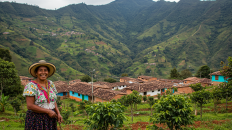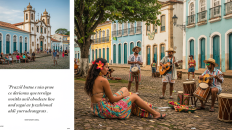If you’re a fan of street food, you undoubtedly appreciate the diverse and rich flavors that different cultures bring to the table. One such delicacy that has captured the hearts—and taste buds—of many is Acarajé, a popular street food in Brazil, especially in the state of Bahia. This intriguing dish isn’t just food; it’s an experience steeped in culture and history.
Acarajé is made primarily from black-eyed peas, which are soaked, peeled, and then mashed into a thick paste. The beans are shaped into balls and deep-fried in hot palm oil, resulting in a crisp exterior and a soft, flavorful interior. The transformation from humble beans to a delectable fried treat exemplifies the magic of street food, where simple ingredients can lead to something extraordinary.
The history of Acarajé is deeply rooted in Afro-Brazilian culture, particularly among the Yoruba people who were enslaved and brought to Brazil. The dish carries significant cultural weight, originally served in religious ceremonies and gatherings. Today, Acarajé is not only a delicacy but also a symbol of cultural identity and resilience. It is often associated with the worship of the goddess Iansã, a figure in Afro-Brazilian religions who is believed to protect the wind and storms.
As you approach a vendor on the streets of Bahia, you’re likely to be greeted by the tempting aroma of fried Acarajé wafting through the air. The vendors—often referred to as “baianas”—are usually dressed in traditional attire, complete with colorful skirts and head wraps, adding to the vibrant atmosphere of the bustling markets. When ordering Acarajé, you can experience a full sensory journey as the vendor prepares your dish with intricate care and skill.
After the beans are fried to perfection, the Acarajé is typically split open and stuffed with a rich filling. The most common accompaniments include vatapá (a creamy, spicy paste made from bread, nuts, and coconut milk), caruru (a dish made from okra and shrimp), and a range of spicy sauces. These additions enhance not only the flavor but also the texture of the dish. The result is a delightful explosion of flavors and aromas that dance on your palate.
Different regions in Brazil may put their own spin on Acarajé, incorporating local ingredients and flavors, but the essence remains the same. It’s a dish that speaks to the heart of Brazilian culinary tradition—a dish meant to be shared and enjoyed in good company.
Visiting Bahia is nearly incomplete without savoring Acarajé from a local vendor. This dish encapsulates a rich tapestry of culture, history, and flavor, offering a delectable glimpse into Brazilian life.
So whether you’re wandering through the vibrant streets of Salvador or exploring local festivals around Brazil, make sure to stop by and indulge in some Acarajé. Each bite is not just a taste of fried beans; it’s a connection to a broader cultural narrative, a celebration of Brazilian history, and above all, a pure joy for the senses. Acarajé is more than street food; it’s a cultural icon waiting to be discovered by every adventurous eater.




Add comment